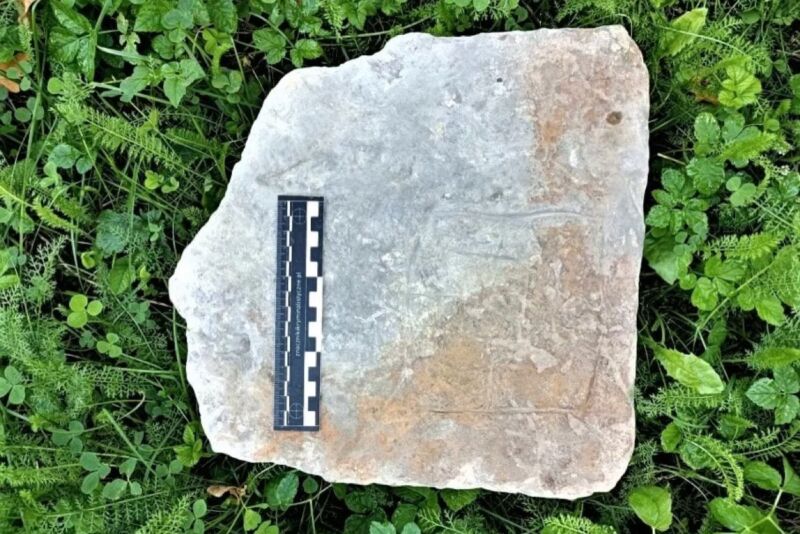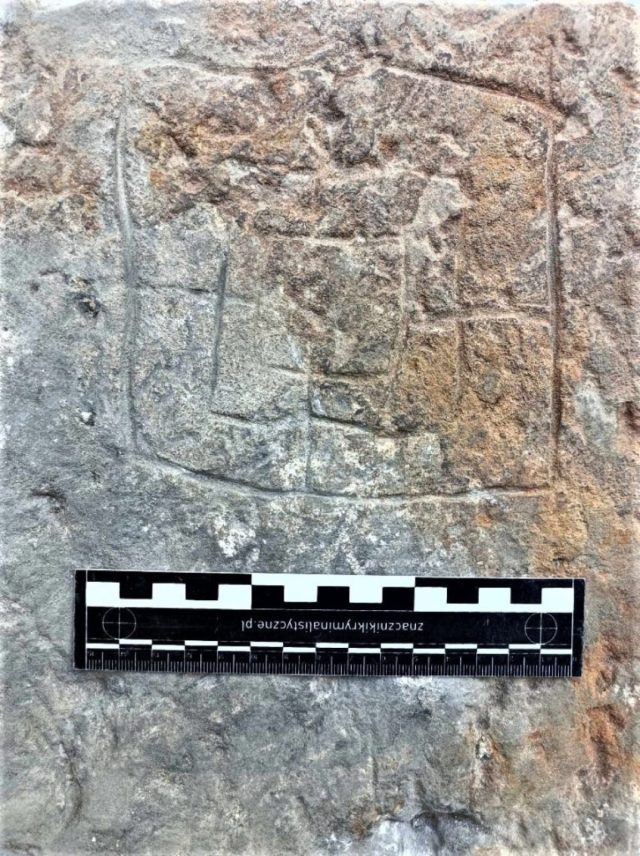
Some 500 years ago, construction workers in the midst of building Ćmielów Castle in Poland carved a simple game board into a slab of the sandstone floor as a diversion for their leisure time. At least that's one possible scenario for the existence of a game board recently discovered by archaeologists in the castle ruins; it's also possible the board could have been carved by children or by servants after the castle was completed, or it may have been meant as a symbolic message.
As previously reported, there is archaeological evidence for various kinds of board games from all over the world dating back millennia: Senet and Mehen in ancient Egypt, for example, or a strategy game called ludus latrunculorum ("game of mercenaries") favored by Roman legions. A 4,000-year-old board discovered last year at an archaeological site in Oman's Qumayrah Valley might be a precursor to an ancient Middle Eastern game known as the Royal Game of Ur (or the Game of Twenty Squares), a two-player game that may have been one of the precursors to backgammon (or was simply replaced in popularity by backgammon). Like backgammon, it's essentially a race game in which players compete to see who can move all their pieces along the board before their opponent.
This latest discovery isn't quite as old as that in terms of the actual carved board, but the game could be just as ancient. According to archaeologist Tomasz Olszacki, it's a two-person strategy board game called Mill, also known as Nine Men's Morris, Merels, or "cowboy checkers" in North America. The earliest-known Mill game board was found carved into the roofing slabs of an Egyptian temple at Kurna, which likely predates the Common Era. Historians believe it was well-known to the Romans, who may have learned of the game through trade routes.
Ovid mentions an early version of the game in his 2nd century CE treatise Ars Amatoria, insisting that women should learn the game, "for love often comes into being during play." And in Shakespeare's A Midsummer Night's Dream, Titania talks about how "the nine men's morris is filled up with mud"—perhaps a reference to the giant outdoor boards carved into medieval village greens. Boards have also been found carved into cloister seats at English cathedrals. A game board was found in a 13th-century church in Opole, Poland, and depictions of people playing the game were inscribed on 15th-century stove tiles in Wielkopolska.

A typical Mill game board is a grid with 24 intersecting points, and players must try to line up three of their nine men horizontally or vertically to form a "mill." When this happens, they can remove one of the other player's pieces from the board. There are also variations with three, six, and 12 pieces per player. First, each player takes a turn placing each of their men (colored black or white) onto one of the empty points. The best strategy is to scatter one's men in various locations rather than trying to form a mill right away since concentrating all your men in one area can block moves as the game progresses.
In the second stage, players take turns moving their men to adjacent points, trying to form mills and remove their opponent's men. If a player's pieces get blocked in, with no adjacent empty spaces, that player loses the game. The other way to win is to reduce the opponent's men down to two, so they can no longer form mills—hence losing the game.
The carved game board found at Ćmielów Castle measures about 13.5 cm, per Olszacki. Built sometime between 1519 and 1531 by a local nobleman named Krzysztof Szydłowiecki, the castle fell into Swedish hands in 1657 and was partially demolished in 1702. The parts still standing became a brewery around 1800, a bathhouse in 1905, and a German military hospital during World War II. The ruined castle eventually passed into private ownership in 2009 and continued its decline. But then it changed hands again in 2022, and archaeological work at the site resumed, leading to the game board's discovery.
Listing image by Tomasz Olszacki
reader comments
52